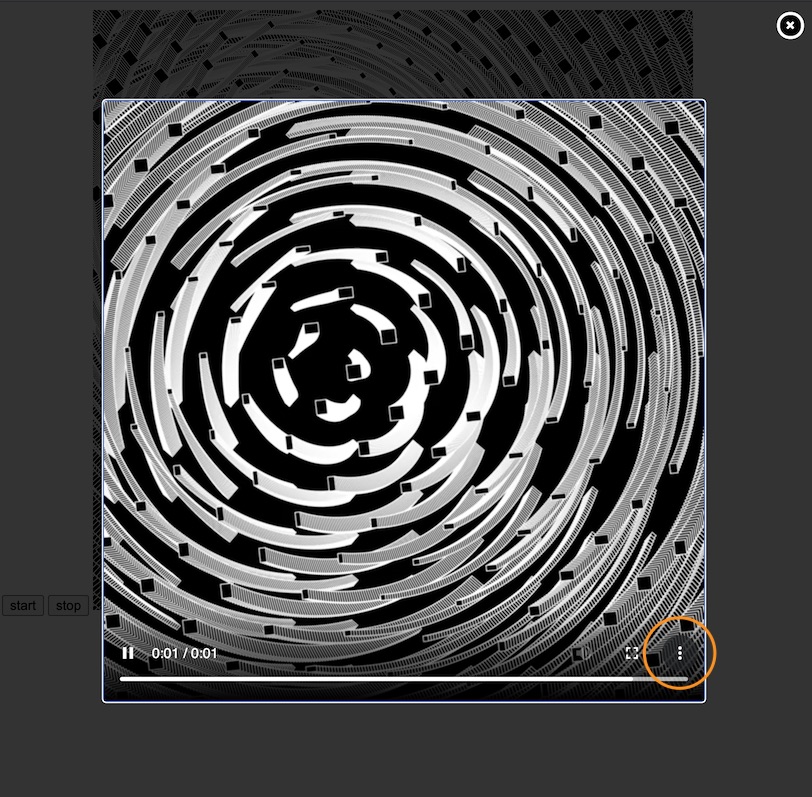Library for easy recording of p5.js sketches and in-browser conversion to MP4.
P5.rec hooks into the p5.js draw loop to produce buttery-smooth results 🧈🎉 to upload to Youtube, Instagram, Twitter, etc.
Unfortunately, p5.rec doesn't work on Firefox at the moment :( (see this issue)
Check out the demo:
👉🏽 Demo on p5js 👈🏽
If you've ever recorded your p5.js sketches with a screen recording tool like quickTime, you might have run into the problem of jerky recordings. If your sketch is too complex, rendering performance drops and frames are missing, since your screen recording tool doesn't know about what it's recording.
p5.rec solves this problem similar to CCapture. It hooks into the p5.js draw() loop. Once the drawing of a single frame is complete, that frame is stored and the next one is rendered. Usually this looks a bit broken in the browser, but the resulting video is guaranteed to contain every single frame in perfect quality.
Import p5.rec from npm to your index.html after importing p5.js:
<head>
...
<script src="https://cdnjs.cloudflare.com/ajax/libs/p5.js/1.0.0/p5.js"></script>
<script type="module" src="https://unpkg.com/p5.rec"></script>
...Launch with startRecording(options) (global mode):
startRecording();and stop your recording with
stopRecording();startRecording( options ): Starts the recording. Don't worry if the p5.js frame starts to look choppy, that's just so that p5.rec can do it's magic 🧙🏼♀️. Options is optional (just like each of its attributes) and gives you more control over the result:
startRecording({
preset: "slow",
// H264 preset. One of [ "ultrafast",
// "superfast",
// "veryfast",
// "faster",
// "fast",
// "medium",
// "slow",
// "slower",
// "veryslow"]
// See https://trac.ffmpeg.org/wiki/Encode/H.264
crf: 18,
// crf (Constant Rate Factor) defines video quality and
// goes from 0 (maximum quality/size) to 51 (worst quality possible)
// See https://trac.ffmpeg.org/wiki/Encode/H.264#crf
onProgress: (progress) => console.log(progress),
// callback for the encoding progress. *progress* is a float from 0 to 1.
onFinish: (videoBuffer) => {},
// callback for the resulting Uint8array. By default, p5.rec shows an overlay for checking and downloading the result.
});stopRecording():
Stops the recording and starts the transcoding. When starting transcoding, p5.rec has to download @ffmpeg/core (around 25MB) which takes a while. Once you see 'starting transcoding' on the console the actual transcoding (and callbacks to onProgress) starts.
When no specific callback is provided for onFinish p5.rec opens an overlay with the result. In Chrome, you can use the 'Download' feature (bottom right) to download the result:
p5.rec at the moment only supports p5's global mode. I'm working on getting it running in instance mode as well (See this issue).
Also in general, p5.rec unfortunately takes a while to do its job. So just be patient :)
Check out the examples from /examples for ways to use p5.rec locally.
You might also want to use:
- CCapture hooks into
requestAnimationFrameto arrive at a similarly smooth result and let's you export webm and gif among others. - p5js-gif-recoder uses CCapture to export gifs directly from p5.
- p5.createLoop creates loops and exports them as gifs from p5.
p5.rec is using @ffmpeg/ffmpeg for doing the transcoding.

